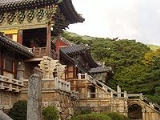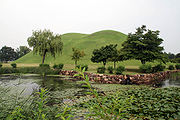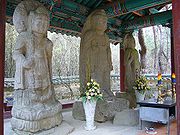
Tourism in Gyeongju
Encyclopedia
Tourism in Gyeongju is a major industry and defining feature of Gyeongju
, South Korea
. Gyeongju is today a major cultural site and tourist destination for South Koreans and foreigners with about 8 to 9 million visitors annually. A great deal of this is due to the city's status as a center of Silla
heritage, derived from its former role as the capital of that ancient kingdom.
. In addition, the Gyeongju National Museum
hosts many artifacts from the Silla kingdom which have been excavated from sites within the city and surrounding areas, including several royal crowns and other national treasures.
Some of Gyeongju's most famous sites relate to the Silla government's patronage of Buddhism
. The grotto of Seokguram
and the temple of Bulguksa
were the first Korean sites to be included on the UNESCO World Heritage List, in 1995. In addition, the ruins of the old Hwangnyongsa
temple, said to have been Korean's largest, are preserved on the slopes of Toham Mountain. Various Silla-era stone carvings of Buddhas and bodhisattvas are found on mountainsides throughout the city, particularly on Namsan
.
The Gyerim
, or "Chicken Forest," adjoins the Royal Tomb Complex in central Gyeongju. So does the Anapji
pond, the Poseokjeong
garden site, and the Cheomseongdae
observatory. Each site is deeply woven into the legends and history of the Silla period.
A number of fortresses from the Silla period have been preserved. These include the Wolseong and Myeonghwal fortresses in the downtown area, and the Bu Mountain Fortress in Geoncheon-eup.
 The tombs of the rulers of Silla are all located within the boundaries of Gyeongju. The identity of the ruler is known in many cases, particularly for the later rulers. However, many of the older tombs found in the Royal Tombs Complex cannot be conclusively tied to any ruler. Partly for this reason, many of the tombs are known by the names of notable artifacts excavated there. One example of this is the Heavenly Horse Tomb
The tombs of the rulers of Silla are all located within the boundaries of Gyeongju. The identity of the ruler is known in many cases, particularly for the later rulers. However, many of the older tombs found in the Royal Tombs Complex cannot be conclusively tied to any ruler. Partly for this reason, many of the tombs are known by the names of notable artifacts excavated there. One example of this is the Heavenly Horse Tomb
, where a mudflap bearing a celestial horse motif was found.
Not all of the Silla-era tombs are royal. The tomb of the general Kim Yu-sin is located on one of the low mountains surrounding Gyeongju Basin.
A notable tomb outside the usual historical precincts of Gyeongju is that of King Munmu
, d. 681
, who was buried at sea just off the coast of Yangbuk-myeon. Munmu, the first king of Unified Silla
, instructed that he should be buried there so that he could become a dragon and protect the Silla coastline.

, a number of relics from that period have been preserved alongside the Silla sites. A few seowon
, Confucian private schools which dotted the Korean countryside during the Joseon Dynasty
, have been preserved. Seoak seowon
is situated in the downtown area, and Oksan Seowon
is preserved in Angang-eup. In Gangdong-myeon, a folk village keeps up the appearances of the late Joseon period. Adjacent to the Royal Tombs Complex in downtown Gyeongju, the houses of the Gyodong neighborhood also keep the hanok
form they had in Joseon times. There are also important architecture built in the Joseon Dynasty. Gyeongju Seokbinggo
is a seokbinggo or ice house located in the neighborhood of Inwang-dong, Gyeongju
, North Gyeongsang province, South Korea
. It was originally built in the Wolseong Fortress in 1738, the 14th year of King Yeongju
. The Gyeongju Seokbinggo has been designated as the 66th Treasure of South Korea and managed by the Department of Culture and Tourism of the Gyeongju City.
Gyodong includes the main house of the Gyeongju Choi clan, which is also a famed brewery of beopju
.
Every year since 1962 a Silla Cultural Festival (신라문화제) has been held in October to celebrate and honour the dynasty's history and culture. It is one of the major festivals of Korea. It features athletic events, folk games, music, dance, literary contests and Buddhist religious ceremonies. Other festivals include the Cherry Blossom Marathon in April, the Korean Traditional Drink and Rice Cake Festivalhttp://sulddeok.gyeongju.go.kr/ in March, and memorial ceremonies for the founders of the Silla Dynasty and General Kim Yu-sin.
Gyeongju
Gyeongju is a coastal city in the far southeastern corner of North Gyeongsang province in South Korea. It is the second largest city by area in the province after Andong, covering with a population of 269,343 people according to the 2008 census. Gyeongju is southeast of Seoul, and east of the...
, South Korea
South Korea
The Republic of Korea , , is a sovereign state in East Asia, located on the southern portion of the Korean Peninsula. It is neighbored by the People's Republic of China to the west, Japan to the east, North Korea to the north, and the East China Sea and Republic of China to the south...
. Gyeongju is today a major cultural site and tourist destination for South Koreans and foreigners with about 8 to 9 million visitors annually. A great deal of this is due to the city's status as a center of Silla
Silla
Silla was one of the Three Kingdoms of Korea, and one of the longest sustained dynasties in...
heritage, derived from its former role as the capital of that ancient kingdom.
Silla remains
Many Silla sites are included in Gyeongju National ParkGyeongju National Park
Gyeongju National Park is located in the providence of Gyeongsangbuk-do, South Korea, and is the country's only historical national park. It was first designated a national park in 1968. The park covers many of the principal Silla historical sites in Gyeongju City...
. In addition, the Gyeongju National Museum
Gyeongju National Museum
The Gyeongju National Museum is a museum in Gyeongju, North Gyeongsang Province, South Korea. Its holdings are largely devoted to relics of the Silla kingdom, of which Gyeongju was the capital....
hosts many artifacts from the Silla kingdom which have been excavated from sites within the city and surrounding areas, including several royal crowns and other national treasures.
Some of Gyeongju's most famous sites relate to the Silla government's patronage of Buddhism
Buddhism
Buddhism is a religion and philosophy encompassing a variety of traditions, beliefs and practices, largely based on teachings attributed to Siddhartha Gautama, commonly known as the Buddha . The Buddha lived and taught in the northeastern Indian subcontinent some time between the 6th and 4th...
. The grotto of Seokguram
Seokguram
The Seokguram Grotto is a hermitage and part of the Bulguksa temple complex. It lies four kilometers east of the temple on Mt. Tohamsan, in Gyeongju, South Korea. It is classified as National Treasure No. 24 by the South Korean government and is located at 994, Jinhyeon-dong, Gyeongju-si,...
and the temple of Bulguksa
Bulguksa
Bulguksa is a head temple of the Jogye Order of Korean Buddhism in the North Gyeongsang province in South Korea. It is home to seven National treasures of South Korea, including Dabotap and Seokgatap stone pagodas, Cheongun-gyo , and two gilt-bronze statues of Buddha. The temple is classified as...
were the first Korean sites to be included on the UNESCO World Heritage List, in 1995. In addition, the ruins of the old Hwangnyongsa
Hwangnyongsa
Hwangnyongsa, or Hwangnyong Temple, is the name of a former Buddhist temple in the city of Gyeongju, South Korea. Built in the 6th century, it was the center of state-sponsored Buddhism during the Silla and Unified Silla eras...
temple, said to have been Korean's largest, are preserved on the slopes of Toham Mountain. Various Silla-era stone carvings of Buddhas and bodhisattvas are found on mountainsides throughout the city, particularly on Namsan
Namsan (Gyeongju)
Namsan is a 494-meter peak in the heart of Gyeongju National Park, just south of Gyeongju, South Korea. The mountain is within easy reach from the city and attracts a large number of national tourists. Namsan covers an area of about 8 km by 12 km...
.
The Gyerim
Gyerim
The Gyerim is a small woodland in Gyeongju National Park, Gyeongju, South Korea. The name literally means "rooster forest." The grove lies near the old site of the Silla kingdom palace in central Gyeongju. Nearby landmarks include the Banwolseong fortress, Cheomseongdae, the Gyeongju National...
, or "Chicken Forest," adjoins the Royal Tomb Complex in central Gyeongju. So does the Anapji
Anapji
Anapji, or Anap Pond is an artificial pond in Gyeongju National Park, South Korea. It was part of the palace complex of ancient Silla . It was constructed by order of King Munmu in 674 CE. The pond is situated at the northeast edge of the Banwolseong palace site, in central Gyeongju. It is an...
pond, the Poseokjeong
Poseokjeong
The Poseokjeong site near Namsan in Gyeongju, Gyeongsangbuk-do South Korea, was built in the Silla period. The site once featured a royal pavilion–said to have been the most beautiful royal villa of the time—, but the only remains today is a granite water feature. This abalone-shaped watercourse...
garden site, and the Cheomseongdae
Cheomseongdae
Cheomseongdae is an astronomical observatory in Gyeongju, South Korea. Cheomseongdae means star-gazing tower in Korean. Cheomseongdae is the oldest surviving observatory in East Asia, and one of the oldest scientific installations on Earth. It dates to the 7th century to the time of kingdom of...
observatory. Each site is deeply woven into the legends and history of the Silla period.
A number of fortresses from the Silla period have been preserved. These include the Wolseong and Myeonghwal fortresses in the downtown area, and the Bu Mountain Fortress in Geoncheon-eup.
Tombs

Heavenly Horse Tomb
Cheonmachong, formerly Tomb No.155, is a tumulus located in Gyeongju, South Korea. The tomb was excavated in 1973 and is believed to date probably from the fifth century but perhaps from the sixth century CE...
, where a mudflap bearing a celestial horse motif was found.
Not all of the Silla-era tombs are royal. The tomb of the general Kim Yu-sin is located on one of the low mountains surrounding Gyeongju Basin.
A notable tomb outside the usual historical precincts of Gyeongju is that of King Munmu
Munmu of Silla
Munmu of Silla was the thirtieth king of the Korean kingdom of Silla. He is usually considered to have been the first ruler of the Unified Silla period. Munmu was the son of King Muyeol and Munmyeong, who was the younger sister of Kim Yu-shin...
, d. 681
681
Year 681 was a common year starting on Tuesday of the Julian calendar. The denomination 681 for this year has been used since the early medieval period, when the Anno Domini calendar era became the prevalent method in Europe for naming years.- Byzantine Empire :* The Bulgars under Asparukh win...
, who was buried at sea just off the coast of Yangbuk-myeon. Munmu, the first king of Unified Silla
Unified Silla
Unified Silla or Later Silla is the name often applied to the Korean kingdom of Silla, one of the Three Kingdoms of Korea, when it conquered Baekje in 660 and Goguryeo in 668, unifying the southern portion of the Korean peninsula...
, instructed that he should be buried there so that he could become a dragon and protect the Silla coastline.

Later sites
Although Gyeongju no longer played a particularly central role during the Joseon DynastyJoseon Dynasty
Joseon , was a Korean state founded by Taejo Yi Seong-gye that lasted for approximately five centuries. It was founded in the aftermath of the overthrow of the Goryeo at what is today the city of Kaesong. Early on, Korea was retitled and the capital was relocated to modern-day Seoul...
, a number of relics from that period have been preserved alongside the Silla sites. A few seowon
Seowon
Seowon were the most common educational institution of Korea during the mid- to late Joseon Dynasty. They were private institutions, and combined the functions of a Confucian shrine and a preparatory school. In educational terms, the seowon were primarily occupied with preparing students for the...
, Confucian private schools which dotted the Korean countryside during the Joseon Dynasty
Joseon Dynasty
Joseon , was a Korean state founded by Taejo Yi Seong-gye that lasted for approximately five centuries. It was founded in the aftermath of the overthrow of the Goryeo at what is today the city of Kaesong. Early on, Korea was retitled and the capital was relocated to modern-day Seoul...
, have been preserved. Seoak seowon
Seoak Seowon
The Seoak Seowon is a seowon located in the neighborhood of Seoak-dong, Gyeongju, North Gyeongsang Province, South Korea. Seowon is a type of local academy during the Joseon Dynasty...
is situated in the downtown area, and Oksan Seowon
Oksan Seowon, Gyeongju
The Oksan Seowon is a seowon located at Oksan-ri, Angang-eup in the city of Gyeongju, North Gyeongsang Province, South Korea. Seowon is a type of local academy during the Joseon Dynasty...
is preserved in Angang-eup. In Gangdong-myeon, a folk village keeps up the appearances of the late Joseon period. Adjacent to the Royal Tombs Complex in downtown Gyeongju, the houses of the Gyodong neighborhood also keep the hanok
Hanok
Hanok is a term to describe Korean traditional houses. Korean architecture lends consideration to the positioning of the house in relation to its surroundings, with thought given to the land and seasons....
form they had in Joseon times. There are also important architecture built in the Joseon Dynasty. Gyeongju Seokbinggo
Gyeongju Seokbinggo
The Gyeongju Seokbinggo is a seokbinggo or ice house located in the neighborhood of Inwang-dong, Gyeongju, North Gyeongsang province, South Korea...
is a seokbinggo or ice house located in the neighborhood of Inwang-dong, Gyeongju
Gyeongju
Gyeongju is a coastal city in the far southeastern corner of North Gyeongsang province in South Korea. It is the second largest city by area in the province after Andong, covering with a population of 269,343 people according to the 2008 census. Gyeongju is southeast of Seoul, and east of the...
, North Gyeongsang province, South Korea
South Korea
The Republic of Korea , , is a sovereign state in East Asia, located on the southern portion of the Korean Peninsula. It is neighbored by the People's Republic of China to the west, Japan to the east, North Korea to the north, and the East China Sea and Republic of China to the south...
. It was originally built in the Wolseong Fortress in 1738, the 14th year of King Yeongju
Yeongjo of Joseon
Yeongjo was the twenty-first king of the Korean Joseon Dynasty. He was the second son of Sukjong by Lady Suk-bin of the Choi clan , succeeded his older brother Gyeongjong.-Reign:...
. The Gyeongju Seokbinggo has been designated as the 66th Treasure of South Korea and managed by the Department of Culture and Tourism of the Gyeongju City.
Gyodong includes the main house of the Gyeongju Choi clan, which is also a famed brewery of beopju
Beopju
Beopju is a traditional Korean rice liquor, of the cheongju family of liquors. It is made chiefly from glutinous rice, and has an alcohol content of about 15%.Beopju first appears in historical records in the Goryeo Dynasty...
.
Conferences and festivals
A significant portion of Gyeongju's tourist traffic is due to the city's successful promotion of itself as a site for various festivals, conferences, and competitions.Every year since 1962 a Silla Cultural Festival (신라문화제) has been held in October to celebrate and honour the dynasty's history and culture. It is one of the major festivals of Korea. It features athletic events, folk games, music, dance, literary contests and Buddhist religious ceremonies. Other festivals include the Cherry Blossom Marathon in April, the Korean Traditional Drink and Rice Cake Festivalhttp://sulddeok.gyeongju.go.kr/ in March, and memorial ceremonies for the founders of the Silla Dynasty and General Kim Yu-sin.

